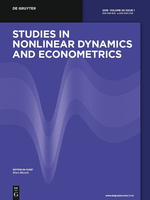
STUDIES IN NONLINEAR DYNAMICS AND ECONOMETRICS
Scope & Guideline
Advancing Insights into Complex Economic Systems
Introduction
Aims and Scopes
- Nonlinear Econometric Models:
The journal publishes research on econometric models that exhibit nonlinear characteristics, such as nonlinear autoregressive models, threshold models, and regime-switching models, allowing for a more accurate representation of economic time series. - Advanced Statistical Methods:
Papers often focus on the development and application of advanced statistical methods, including Bayesian inference, copulas, and score-driven models, which enhance the understanding of economic dynamics and volatility. - Multivariate Time Series Analysis:
Research frequently explores multivariate time series techniques, investigating dependencies and interactions among multiple economic indicators, providing insights into complex economic relationships. - Financial Econometrics:
The journal covers topics in financial econometrics, particularly those related to volatility modeling, risk assessment, and the dynamics of financial markets, contributing to both theoretical and applied finance. - Policy Evaluation and Economic Dynamics:
Papers often address the implications of economic policies and shocks, utilizing dynamic models to evaluate their effects on various economic indicators, thus bridging theory and practical policy analysis.
Trending and Emerging
- Machine Learning and AI in Econometrics:
There is a growing trend towards incorporating machine learning and artificial intelligence techniques into econometric analysis, as seen in studies utilizing neural networks and advanced predictive modeling to enhance forecasting accuracy. - Causal Inference and Structural Models:
Emerging interest in causal inference methods, particularly in the context of structural econometric models, indicates a shift towards understanding the underlying mechanisms of economic phenomena rather than mere correlations. - Complex Network Analysis in Economics:
Research exploring complex networks, particularly in financial markets and economic systems, is gaining traction, reflecting a broader interest in understanding interconnections and dependencies among economic agents. - Real-Time Data and Forecasting:
The use of real-time data for forecasting economic indicators is increasingly prominent, addressing the need for timely and relevant insights that can inform policy decisions and market strategies. - Sustainability and Economic Dynamics:
There is a rising focus on the interplay between economic dynamics and sustainability, with studies examining the impact of environmental factors and policies on economic behavior and growth.
Declining or Waning
- Traditional Linear Econometric Models:
There has been a noticeable decline in the publication of research focusing on traditional linear econometric models, as the field increasingly embraces nonlinear approaches that better capture the complexities of economic data. - Static Econometric Analysis:
Research centered on static models and analyses has decreased, with a shift towards dynamic modeling that accounts for time-varying relationships and structures in economic data. - Deterministic Economic Models:
Deterministic models, which assume fixed relationships without accounting for randomness and uncertainty, are less frequently published, indicating a growing preference for stochastic modeling techniques that incorporate uncertainty. - Simplistic Volatility Models:
The journal has seen fewer studies utilizing simplistic GARCH models without extensions or modifications, as researchers now favor more complex models that capture intricate patterns in volatility.
Similar Journals
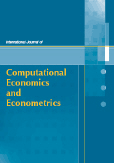
International Journal of Computational Economics and Econometrics
Exploring the intersection of technology and economic theory.International Journal of Computational Economics and Econometrics is a peer-reviewed academic journal published by INDERSCIENCE ENTERPRISES LTD, focusing on the intersection of computational methodologies and economic analysis. With an ISSN of 1757-1170 and an E-ISSN of 1757-1189, this journal provides a crucial platform for researchers and professionals interested in innovative computational approaches to tackle real-world economic problems. While it currently does not operate under an open-access model, the journal is committed to advancing knowledge in its field, particularly as it occupies a vital niche within Computer Science Applications and Economics and Econometrics, ranking in the Q4 quartile for both categories as of 2023. Covering the period from 2017 to 2024, the journal aims to foster interdisciplinary collaboration and encourage the integration of advanced computational techniques into traditional economic theory and practice. As it continues to evolve, the International Journal of Computational Economics and Econometrics remains essential for academics and practitioners looking to stay at the forefront of technological innovations in economics.

Econometric Reviews
Pioneering Research at the Intersection of Economics and DataEconometric Reviews, published by Taylor & Francis Inc, is a premier journal in the field of Economics and Econometrics, recognized for its significant contributions to the advancement of economic theory and practice since its inception. With its ISSN 0747-4938 and E-ISSN 1532-4168, the journal has maintained a consistent publication record from 1982 to 2024, offering a platform for groundbreaking research that shapes the landscape of quantitative economic analysis. With a proud place in the Q1 category for Economics and Econometrics as of 2023, it stands as a critical resource for scholars, practitioners, and students alike, actively engaging with themes such as econometric methods, theory, and policy implications. Although operating under a subscription model, the journal’s high impact factor reflects its esteem within the academic community, fostering a rich dialogue among researchers in this evolving discipline. The journal’s office is located at 530 Walnut Street, Ste 850, Philadelphia, PA 19106, USA, forging connections in one of the central hubs of economic research.
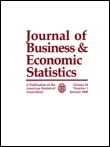
JOURNAL OF BUSINESS & ECONOMIC STATISTICS
Championing High-Quality Research in Business AnalyticsJOURNAL OF BUSINESS & ECONOMIC STATISTICS is a premier academic journal published by Taylor & Francis Inc, dedicated to disseminating high-quality research in the fields of business, economics, and statistics. With an impressive impact in the academic community, the journal maintains a distinguished Q1 ranking across various categories including Economics and Econometrics, Social Sciences (miscellaneous), and Statistics and Probability, showcasing its relevance and influence in contemporary research. Since its inception in 1983, the journal has served as a vital resource for researchers, professionals, and students seeking insights into quantitative methodologies and their application in the economic domain. While the journal is not currently open access, its rigorous peer-review process ensures that published articles are of the highest scholarly standards. Researchers and practitioners alike will find a rich repository of empirical and theoretical studies that foster knowledge advancement in the intersecting realms of business, economics, and statistical analysis.
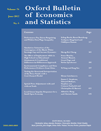
OXFORD BULLETIN OF ECONOMICS AND STATISTICS
Fostering innovation in statistical methodologies.The Oxford Bulletin of Economics and Statistics, published by Wiley, stands as a leading journal in the realms of Economics, Econometrics, and Statistics. Since its inception in 1973 and converging through to 2024, the journal has consistently positioned itself in the top quartile (Q1) across multiple categories, including Economics and Econometrics, Social Sciences, and Statistics and Probability, highlighting its influential status in the academic community. With a commendable ranking within Scopus, notably ranked #53 in Social Sciences and #28 in Statistics and Probability, it serves as a critical platform for disseminating rigorous research and innovative methodologies. Researchers, professionals, and students are encouraged to contribute and engage with the high-quality content that defines this esteemed journal, which does not currently offer Open Access but remains a pivotal resource for those seeking to deepen their understanding of economic and statistical paradigms in the pressing global landscape.

Econometrics, published by MDPI, is a prominent open access journal based in Switzerland, dedicated to advancing research in the fields of economics and econometrics. Since its inception in 2013, this journal has been pivotal in disseminating innovative theories and empirical findings, fostering an engaging dialogue among scholars and practitioners. With an impressive Q2 ranking in the 2023 category of Economics and Econometrics and a solid position at #378 out of 716 in Scopus rankings, it stands as a vital resource for those seeking to enhance their understanding and application of econometric methods. The journal offers immediate open access to its published articles, ensuring that researchers, professionals, and students alike can easily access and contribute to the evolving body of knowledge in this essential discipline. The scope of Econometrics encourages submissions that cover a broad array of topics, making it a dynamic platform for innovative research until 2024 and beyond.

Econometrics and Statistics
Transforming data into impactful insights for diverse fields.Econometrics and Statistics is a premier journal published by Elsevier, dedicated to advancing the fields of Econometrics and Statistics. Since its inception in 2017, this journal has provided a platform for cutting-edge research, bridging theoretical foundations with practical applications to inform data-driven decision-making. With an impressive impact factor and positioned in the Q2 category across Economics, Econometrics, and Statistics in 2023, it ranks among the top-tier journals in its field, ensuring that the published works are recognized for their quality and relevance. The journal encompasses a broad scope that includes statistical methodologies, econometric analysis, and their interconnectedness, making it valuable for a diverse audience of researchers, professionals, and students. Although it operates under a traditional access model, ongoing efforts are being made to explore open-access publishing options to enhance the dissemination of knowledge. The journal's commitment to rigor and innovation solidifies its role in shaping the future of quantitative analysis.

Central European Journal of Economic Modelling and Econometrics
Advancing economic insights through rigorous modeling.Central European Journal of Economic Modelling and Econometrics (ISSN: 2080-0886, E-ISSN: 2080-119X) is a premier academic publication housed under the auspices of the Polish Academy of Sciences - Lodz Branch. Since its establishment, this journal has served as a crucial platform for scholars and practitioners alike, focusing on the dynamic realms of economic modeling and econometrics. The journal is dedicated to advancing the understanding of economic systems and statistical methodologies, striving to bridge theoretical approaches with practical applications. Although currently categorized in the Q4 quartile across various fields such as Applied Mathematics, Economics, and Statistics, its commitment to rigorous research and scholarly discourse ensures it remains an important resource for academics looking to contribute insights in these sectors. Published in Poland and featuring articles aimed at enhancing the body of knowledge in econometric modeling, this journal embraces an open-access model, allowing for greater dissemination of research findings to a global audience. Researchers, professionals, and students will find valuable contributions that not only highlight emerging trends but also foster innovation in the field of economic sciences.
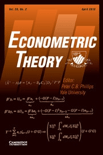
ECONOMETRIC THEORY
Unraveling the Complexities of Economic AnalysisECONOMETRIC THEORY is a premier journal published by Cambridge University Press, specializing in the intricate field of econometrics. With a strong commitment to advancing economic research since its inception in 1985, this journal has earned a distinguished reputation as reflected by its Q1 rankings in both Economics and Econometrics, as well as in Social Sciences (miscellaneous) categories for 2023. With ISSN 0266-4666 and E-ISSN 1469-4360, it serves as an invaluable resource for scholars, researchers, and practitioners who seek to contribute to the field through high-quality, impactful research. Although open access is not available, the journal ensures rigorous peer review and publication standards, solidifying its position as a vital platform for disseminating crucial findings in econometric methodology, empirical applications, and theoretical advancements. With an impressive Scopus ranking, particularly within its broad categories, ECONOMETRIC THEORY is essential reading for those looking to stay at the forefront of research in econometrics.
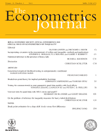
Econometrics Journal
Catalyzing Knowledge in the World of EconometricsEconometrics Journal, published by Oxford University Press, stands as a premier outlet for original research in the fields of Economics and Econometrics, boasting a commendable 2023 Q1 ranking within its category and an impressive 69th percentile rank in Scopus. Since its inception in 2006, the journal has consistently provided a platform for innovative methodologies and applications that contribute to the advancement of econometric theory and practice. With a focus on high-quality, peer-reviewed articles, the journal serves as a vital resource for researchers, professionals, and students alike, facilitating the dissemination of cutting-edge insights that push the boundaries of knowledge in economic analysis. Although it operates under a traditional subscription model, the journal's commitment to excellence and relevance in modern economic discourse positions it as an essential reference for those seeking to navigate the complexities of econometric research.

ECONOMETRICA
Inspiring the next generation of economic scholars.ECONOMETRICA, published by Wiley, is a leading journal in the field of economics and econometrics, renowned for its rigorous and cutting-edge research contributions. With an ISSN of 0012-9682 and an E-ISSN of 1468-0262, this esteemed journal holds a prestigious position in the academic landscape, classified in the top quartile (Q1) for both Economics and Econometrics as of 2023, and ranked 42 out of 716 in its field, placing it in the 94th percentile according to Scopus metrics. The journal's scope encompasses a diverse range of topics aimed at advancing economic theory and its practical applications, making it an essential resource for scholars, practitioners, and students alike. Although it operates under a subscription model, the depth and quality of research published in ECONOMETRICA underscore its significance as a cornerstone for intellectual discourse and innovation within the field. Based in the United Kingdom, at 111 River St, Hoboken, NJ 07030-5774, ECONOMETRICA continues to attract high-caliber contributions that shape the future of econometric research.